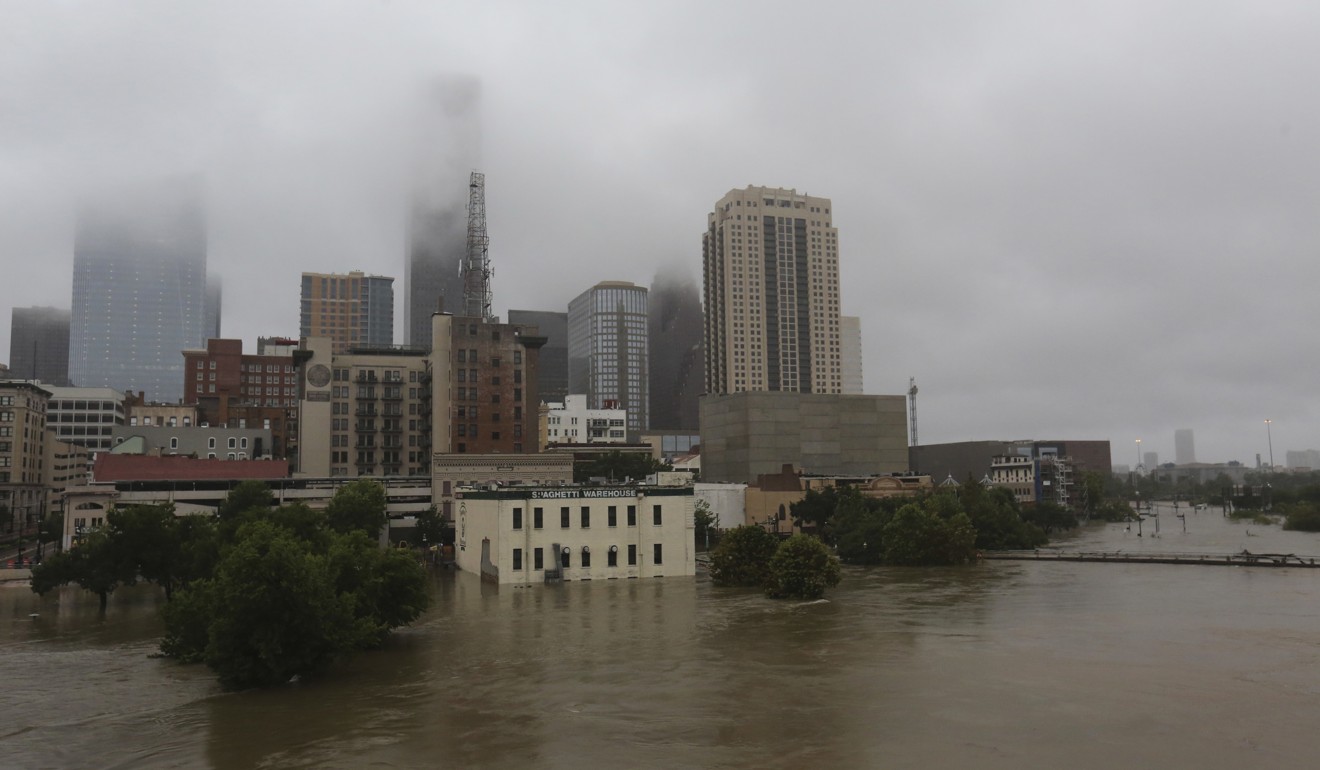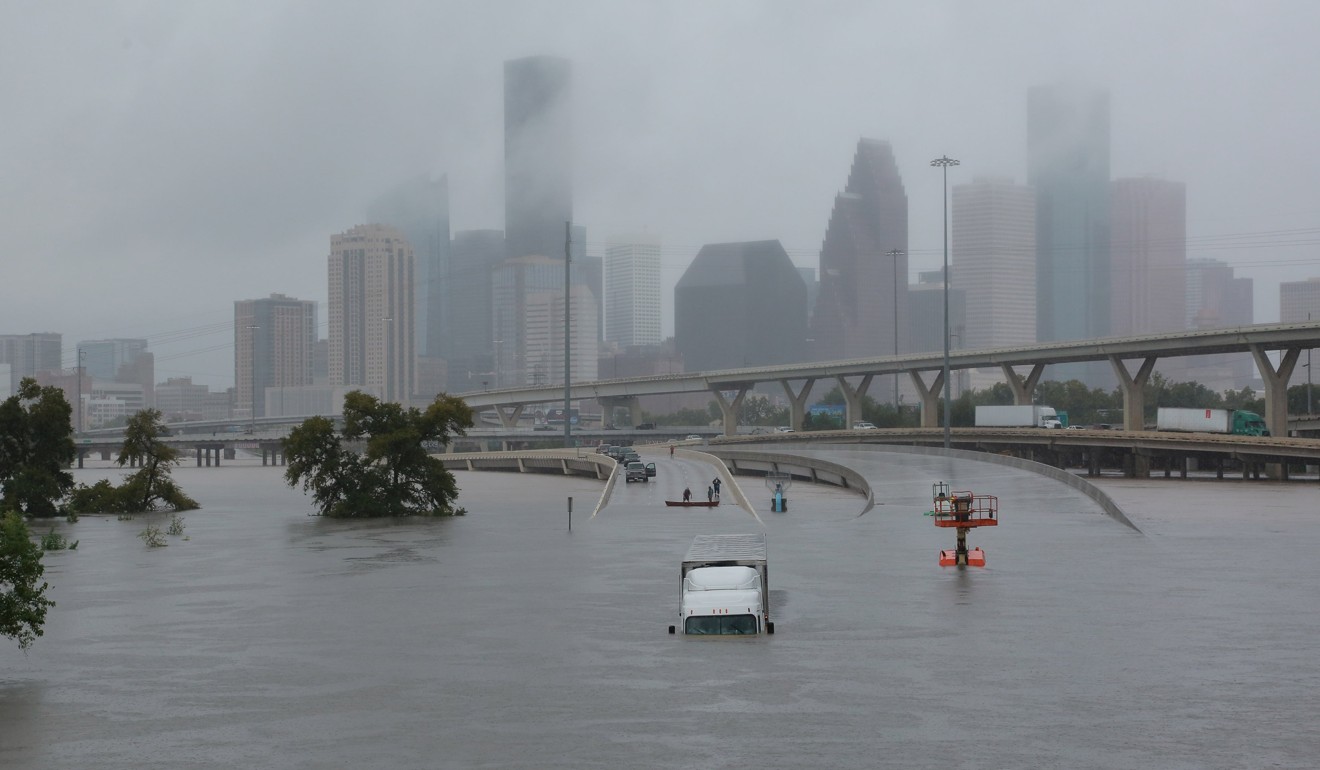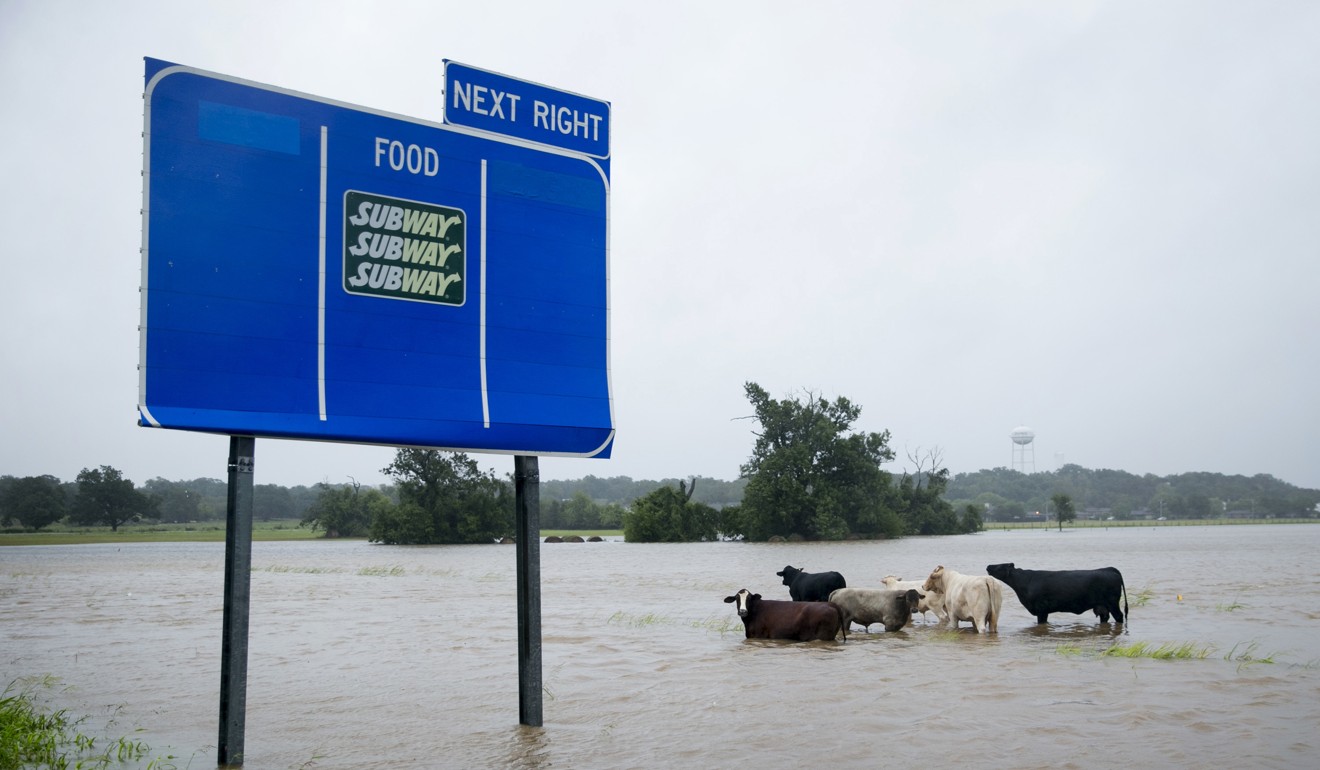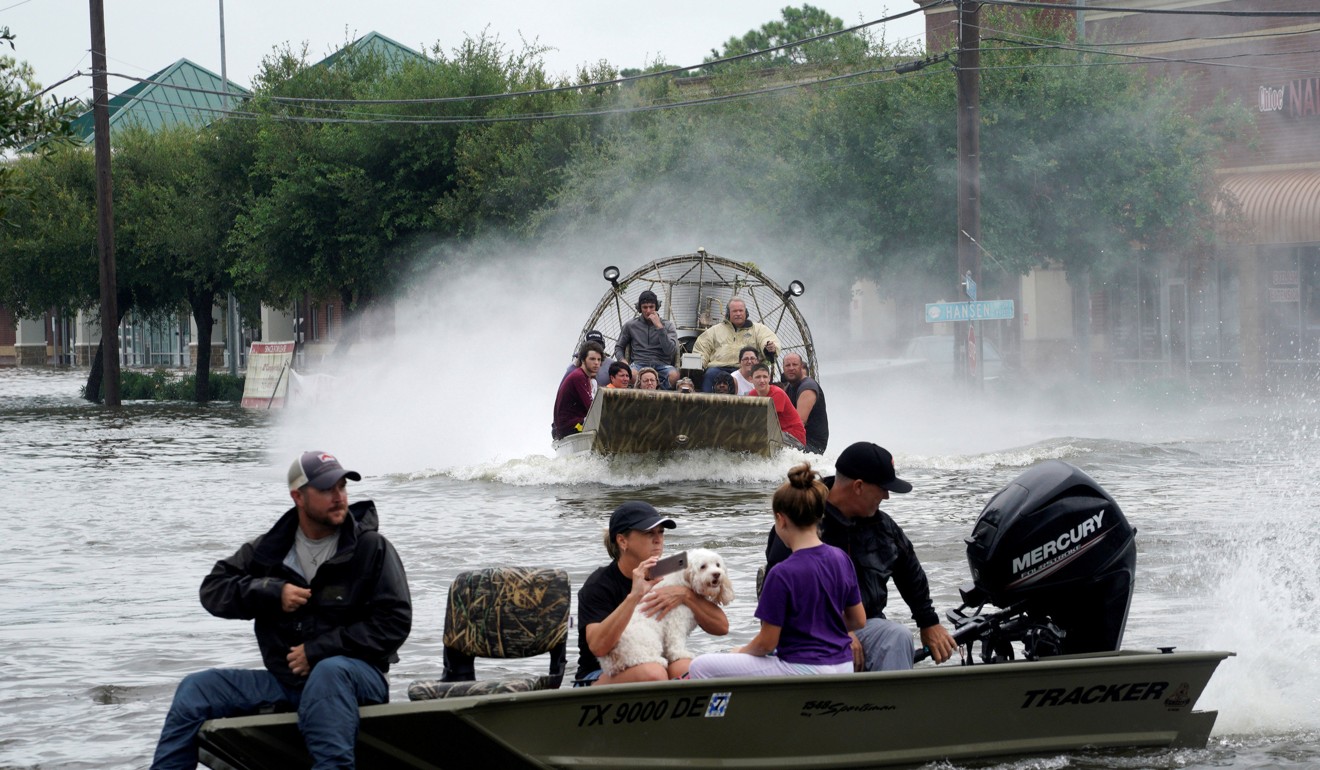
‘Pack up and get out’: flooded Houston ravaged by more rain from Tropical Storm Harvey
Rescuers overwhelmed as officials are forced to release waters from reservoirs to save downtown Houston; six people confirmed dead in disaster
Floodwaters reached the roof lines of single-story homes on Monday and people could be heard pleading for help from inside as Harvey poured rain on the Houston area for a fourth consecutive day after a chaotic weekend of rising water and rescues.
The nation’s fourth-largest city was still largely paralysed, and there was no relief in sight from the storm that spun into Texas as a Category 4 hurricane, then parked itself over the Gulf Coast. With nearly 2 more feet of rain expected, authorities worried whether the worst was yet to come.
Texas officials said on Monday that six more people are feared to have died in the Houston area as a result of torrential rains unleashed by Harvey over the weekend.
Tricia Bentley, spokeswoman for the medical examiner’s office in Harris County which includes the city of Houston, confirmed six deaths since Sunday that are “potentially tied to Hurricane Harvey.”
Harvey, which made landfall late on Friday as a category 4 hurricane and is now dropping heavy rain as a tropical storm, sent devastating floods pouring into Houston on Sunday. The rising water chased thousands of people to rooftops or higher ground and overwhelmed rescuers who could not keep up with calls for help.
The director of the National Weather Service warned that the catastrophic flooding that has overwhelmed the fourth largest US city and other parts of Texas was set to worsen in the coming days.
Director Louis Uccellini said up to 51cm of rain could fall in the coming days, on top of the more than 76cm some places have already seen.

Pack up what you need and put it in your vehicle and when the sun comes up, get out
The disaster unfolded on an epic scale in one of America’s most sprawling metropolitan centres. The Houston metro area covers about 10,000 square miles, an area slightly bigger than New Jersey. It’s crisscrossed by about 1,700 miles of channels, creeks and bayous that drain into the Gulf of Mexico, about 50 miles to the southeast from downtown.
The flooding was so widespread that the levels of city waterways have either equaled or surpassed those of Tropical Storm Allison from 2001, and no major highway has been spared some overflow.
US President Donald Trump on Monday declared an emergency in Louisiana as part of the southern state was being pelted with rain. The declaration allowed the Federal Emergency Management Agency to coordinate relief efforts, as well as disaster relief funding
“This action will help alleviate the hardship and suffering that the emergency has inflicted on the local population,” the White House said.
President Donald Trump is set to visit Texas on Tuesday.
In a series of tweets, Trump said his administration was handling its responsibilities well.
“Wow – Now experts are calling #Harvey a once in 500 year flood! We have an all-out effort going, and going well!”
Later, he added: “HISTORIC rainfall in Houston, and all over Texas. Floods are unprecedented, and more rain coming. Spirit of the people is incredible. Thanks!”
Sewage-laden floodwaters dumped on Texas by Hurricane Harvey bring a higher risk of disease, such as bacterial infections and mosquito-borne illnesses, and the fallout may linger for years, experts warn.
Immediate risks from floods include death by drowning, often people drown in their cars as they try to flee, electrocution, and hypothermia.
The long-term picture could be even more dire, as communities grapple with immense amounts of polluted water in the streets, in homes and businesses.
When floodwater washes over a heavily populated metro area like Houston, it is sure to be dirty and dangerous, experts say.
“There is sewage, all kinds of pesticide, waste, herbicides and toxins that we don’t even know of are all going to wash in,” Ranit Mishori, a family doctor and a professor at Georgetown University School of Medicine. “We are talking hundreds of different types of bacteria and viruses that could contaminate that water.”

People can get sick simply by wading through dirty floodwater with a scratch or an open wound.
“The biggest issue is the release of sewage and bacterial-related infections,” said Howard Selinger, chair of family medicine at the Frank H Netter MD School at Quinnipiac University.
Dirty water can also infiltrate the drinking water system, raising the risk of contaminated water and with it, cholera.
Cholera causes acute diarrhoea, causing some three to five million cases of illness and more than 100,000 deaths each year worldwide.
“The spread of cholera is one of the most significant dangers following any natural disaster, but especially flooding after a hurricane,” said Robert Glatter, an emergency physician at Lenox Hill Hospital in New York.
With more than 450,000 people likely to seek help as a result of the floods, US emergency management officials said they were committed to getting federal resources to Texas as quickly as possible. More than 30,000 people were expected to be placed temporarily in shelters, the Federal Emergency Management Agency said.
Agency director Brock Long said 50 counties in Texas had been affected by the flooding and southwest Louisiana was expected to see major falls also. The rain has been blamed in at least two deaths.

Residents living near the Addicks and Barker reservoirs – designed to prevent flooding in downtown Houston – were warned on Sunday that a controlled release would cause additional flooding that could spill into homes. The dams were coming under massive pressure that could have caused failure without the release.
“The idea is to prepare ... pack up what you need and put it in your vehicle and when the sun comes up, get out,” said Jeff Lindner, from the Harris County Flood Control District. “And you don’t have to go far, you just need to get out of this area.”
The Army Corps of Engineers started the reservoir releases before 2am on Monday – ahead of schedule – because water levels were rising at a rate of more than 15cm per hour, a spokesman said.
County Judge Robert Herbert said National Weather Service officials were predicting that river waters could rise to 18 metres, 90cm above 2016 records and what Herbert called an “800-year flood level”.
Sunday’s incessant rain covered much of Houston in turbid, grey-green water and turned streets into rivers navigable only by boat. In a rescue effort that recalled the aftermath of Hurricane Katrina, helicopters landed near flooded freeways, airboats buzzed across submerged neighbourhoods and high-wheeled vehicles ploughed through waterlogged intersections.
Some people managed with kayaks or canoes or swam.
Volunteers joined emergency teams to pull people from their homes or from the water, which was high enough in places to gush into second floors.
The flooding was so widespread that authorities had trouble pinpointing the worst areas. They urged people to get on top of their homes to avoid becoming trapped in attics and to wave sheets or towels to draw attention to their location.

Being forced to evacuate, live in a makeshift shelter, and losing one’s possessions can all cause mental trauma that lasts long after the event, experts say.
Hospitals may fill up quickly, and people may have a hard time getting life saving medications and health care.
Over the weeks and months to come, soggy buildings will grow mould, which can be toxic and can cause a host of health problems for people exposed.
As the water rose, the weather service offered an ominous forecast: Before the storm that arrived Friday as a Category 4 hurricane is gone, some parts of Houston and its suburbs could get as much as 1,300mm of rain. That would be the highest amount ever recorded in Texas.
Some areas have already received about half that amount. Since Thursday, South Houston recorded nearly 630mm, and the suburbs of Santa Fe and Dayton had 690mm.
“The breadth and intensity of this rainfall is beyond anything experienced before,” the National Weather Service said in a statement.
Elderly nursing homes were inundated with chest-high waters, while residents were forced to flee their homes with what belongings they could carry.

“When I was younger, I used to wish I had a daughter, but I have the best son in the world,” she said. “In my 40 years here, I’ve never seen the water this high.”

“When they told us the current was getting high, we had to bust a window to get out,” Leho said.
William Cain sought shelter after water started coming inside his family’s flat and they lost power. “I live in a lake where there was once dry land,” he said.
The amount of water was so unprecedented that meteorologists had to update the colour charts on the weather service’s rainfall maps.
Rescuers were giving priority to life-and-death situations, leaving many affected families to fend for themselves. Several hospitals in the Houston area were evacuated due to the rising waters.


.png?itok=arIb17P0)